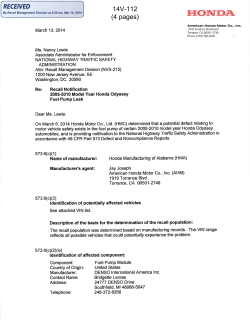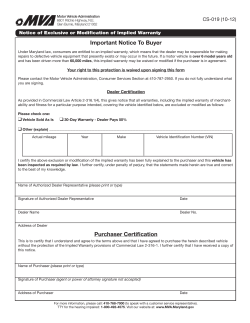
For your convenience, use the handy checklist provided below
For your convenience, use the handy checklist provided below to ensure you have all of the suggested materials referenced in the attached Honda “Winter Storage Guide”. Motorcycle Cover ► □ Please see Dealer for correct application. Battery Charger ► □ P/N 31670-BMS004 Fuel Stabilizer ► □ P/N CB66940 Genuine Honda Engine Oil ► □ Please consult your Owner’s Manual or see Dealer for correct Oil and Filter requirements. Brake Fluid DOT4 ► □ P/N 08203-0004 Coolant ► □ P/N 08C50-C321-S01 Cleaner & Polish ► □ P/N CB66946 Chain Lube ► □ P/N CB66944 Brake Cleaner ► □ P/N CB67160 NOTES: _____________________________________________________ _____________________________________________________ _____________________________________________________ FUEL SYSTEM Winter Storage Guide INTRODUCTION Improper storage of your Honda can lead to numerous problems, including a discharged battery, rusted fuel tank, clogged fuel lines or carburetors, faded paint, rust, mildew, and in certain conditions, even severe engine damage. By following these storage guidelines in conjunction with the Owner's Manual and Service Manual information, your Honda will be ready to ride in the spring. This guide can also be used to prepare Honda ATVs, scooters and Power Equipment for winter storage. Use the information contained in this guide as applicable. If you have doubts about your ability to perform any of the procedures in this storage guide, contact your local Honda dealer. To ensure proper storage, the following sections should be completed in the order in which they are presented. LOCATION For a fee, many dealerships will store your Honda for the winter and prepare it for the next riding season. Ask your local Honda dealer if they provide this service. If you decide to store the vehicle yourself, follow these guidelines: • Store the vehicle in an area that is dry, secure, out of the weather, and out of the way, but accessible for periodic checks. Also, store the vehicle in an area with a minimum of daily temperature variation. • Choose a location away from windows; ultraviolet light can fade paint and plastic parts. Direct sunlight can raise the ambient temperature of the storage area, promoting condensation. • When ready for storage, cover the vehicle with a specially designed, breathable cover such as a Genuine Honda Accessories cover available at your Honda dealer. Do not use tarps or cotton sheets—they will trap or hold moisture against your vehicle, promoting rust and mildew. 2 Work in a well ventilated area. Keep cigarettes, flames or sparks away from the work area or where gasoline is stored. Fuel tank preparation is a vital part of winter storage. There are two ways to prepare the fuel tank for storage: • The first method is to completely drain the fuel tank, leaving it dry for the storage period. If you use this method, lightly spray the inside of the tank with a fuel-soluble anti-rust agent. • The second method (recommended for fuel-injected models) is to fill the tank completely with fresh fuel. The proper level is just up to the bottom of the fuel filler neck. When filling the tank, avoid oxygenated fuels if you can (those known to contain ethanol or methanol), as they absorb water and cause rust. If you are certain that you will not be riding the vehicle for at least 4 to 6 weeks, add a fuel stabilizer such as Pro Honda Fuel Stabilizer or equivalent to the tank before filling it with fuel. If the vehicle will be stored more than three months before you ride, you should also drain the fuel shut-off valve, fuel lines, and the carburetor(s) float bowl(s). If fuel is left for an extended period of time it will go “stale,” turning into a residue that can plug fuel lines and the jets and passages in your carburetors; the addition of fuel stabilizer will prevent this from happening and will help keep moisture from accumulating in the tank. ENGINE OIL Change the engine oil. Even if the oil is not due for a change, combustion byproducts produce acids in the oil that can corrode engine parts. Changing the oil will help prevent corrosion from occurring during storage. Ride the vehicle until it reaches normal operating temperature and then change the engine oil and filter according to the Owner's Manual or Service Manual. Riding the vehicle also does the important task of distributing the treated fuel through the fuel system. Dispose of the used oil and filter in an environmentally safe manner. If you cannot locate an oil recycling facility, contact your local Honda dealer. CYLINDERS Cylinder walls can rust if the engine is not run for several weeks, potentially causing piston and ring wear. To prevent rust during storage, first clean the area around the outside of the spark plugs to ensure debris does not enter the cylinders. Remove the spark plugs from each cylinder and unplug them from their caps. Pour a tablespoon (15-20 cc) of clean engine oil in each cylinder. Cover the spark plug holes with a piece of cloth, turn the engine stop switch to the RUN position, then crank the engine through several revolutions to coat the cylinder walls with oil. Reinstall the spark plug. BATTERY Remove the battery for storage and be sure to read all charging information in the Owner's Manual, on the battery itself, and the instructions that came with the battery charger you'll be using. If the battery is a conventional (not maintenance-free) type, check the electrolyte level. Add distilled water to any cells that are low. Do not use tap water; it will shorten the battery's life considerably. Honda recommends using a compact automatic charger, as they can be left connected without risking damage to the battery. inside and protected from freezing. (Note: Do not store the battery on a concrete floor. A wooden shelf or other non-conductive material is best) With the battery out of the box, it's a good time to clean the battery compartment. Neutralize any acid spills with baking soda and then rinse with clean water. Dry the compartment thoroughly. BRAKE AND CLUTCH SYSTEMS If the brake or clutch fluids haven't been changed in the last two years or 19,300 kilometers, do it now. The fluids in these systems absorb moisture that will cause corrosion and potential problems when you use your vehicle after storage. Use fresh Pro Honda DOT 4 Brake Fluid from a sealed container for the brake and hydraulic clutch systems. Be sure to read all warning labels on the fluid containers and those in the appropriate sections of the Owner's Manual. Refer to the Service Manual for all the information needed to change the fluid in both systems. As brake fluid can damage both paint and plastic, protect those areas of the vehicle when changing or adding brake fluid. Clean any spills immediately with a mild detergent and water solution. Dispose of the used fluid in an environmentally safe manner. If you cannot locate a recycling facility or have any doubts about your ability to change the fluid levels, see your local Honda dealer. COOLING SYSTEM The Honda Optimate 3+ automatic charger (Honda Part Number: 31670-BMS-004), charges the battery as required switching on and off automatically, maintaining a full charge at all times. Find a well-ventilated location to store the battery and charger. Since you will need to check the battery's charge at least every two weeks, store them in an accessible location that is If your vehicle is liquid cooled and the coolant hasn't been changed in the last two years or 38,600 kilometers, do it now. To drain the coolant, follow the procedures in the Owner's Manual or Service Manual. Refill the system with Pro Honda HP Coolant or equivalent. If you mix your own coolant and water, be sure to use distilled water. Any water other than distilled contains minerals that will react with the aluminum parts in the engine and radiator, causing corrosion. If you are going to store your vehicle for more than six months, drain the system completely and leave it dry. Leaving the system dry will assure that no corrosion takes place during storage. After draining the system, put a tag or label on the bike to remind yourself to fill it when you take the vehicle out of storage. If the drained coolant is fresh, store it in sealable containers or, if not, dispose of it properly. If you are unsure of where to dispose of used coolant, contact your local Honda dealer. CLEAN THE VEHICLE If the vehicle is moderately dirty or you have been riding it on salted roads, clean the vehicle thoroughly. Rinse with water if necessary and dry the vehicle completely. Apply Pro Honda Spray Cleaner and Polish, which leaves a protective coating that repels water and protects against ultraviolet rays on both metal and plastic parts. Wax all painted surfaces to prevent paint oxidation and apply rust-inhibiting oil to all chrome pieces. Note: Do not use products containing wax on matte painted surfaces. FINAL STORAGE PREPARATION Make sure the drive chain is dry, and then coat it with Pro Honda Chain Lube. Check that the tire air pressure is correct and place the vehicle in its storage location. Place the vehicle on its centerstand (if equipped) and place a block under the engine so that the front wheel is off the ground. Stable motorcycle stands will also work if the vehicle does not have a centerstand. If you don't have either of these, make sure to check for the correct tire air pressure at least once a month during storage to prevent flat spots. If you are concerned about the security of your vehicle during storage, consider securing the frame to a permanent fixture with a heavy-duty lock or chain, making sure not to damage the frame or paint. Apply the breathable cover and you're set for the winter. Just make sure to keep an eye on the battery's charge! PREPARING TO RIDE (Spring) At the beginning of the riding season, remove the cover and any locks you may have used to secure the vehicle. Check tires for cracks or splits on the sidewalls. Normal "weather checking" shouldn't be a concern. However, if you find large cracks or splits, tire replacement is recommended. See your local Honda dealer. If you haven't found any deterioration, check the air pressure to be sure it's as recommended in the Owner's Manual. Check the vehicle for any rust that may have accumulated during storage. If found, remove it with Pro Honda Spray Cleaner and Polish. Next, lube the drive chain. If you drained the radiator, fill it and remove the tag or label noting it was drained. Reorder: S9507 ©2003 American Honda Motor Co., Inc. MJA5607-10411 (0311) 200000311 Even though you changed the engine oil before storage, change it again if the vehicle has been stored for more than four months; small amounts of oil left in the engine from previous oil changes can create corrosive byproducts during storage. Clean the battery terminals with a wire brush and coat them with dielectric grease. Reinstall the battery. Clean both sides of the brake discs with Pro Honda Brake Cleaner or equivalent. Complete the pre-ride inspection procedures found in the Owner's Manual, then test ride the vehicle at low speeds. If you have completed the storage and preparing to ride procedures as outlined in this guide, you’re ready for another riding season.
© Copyright 2025





















